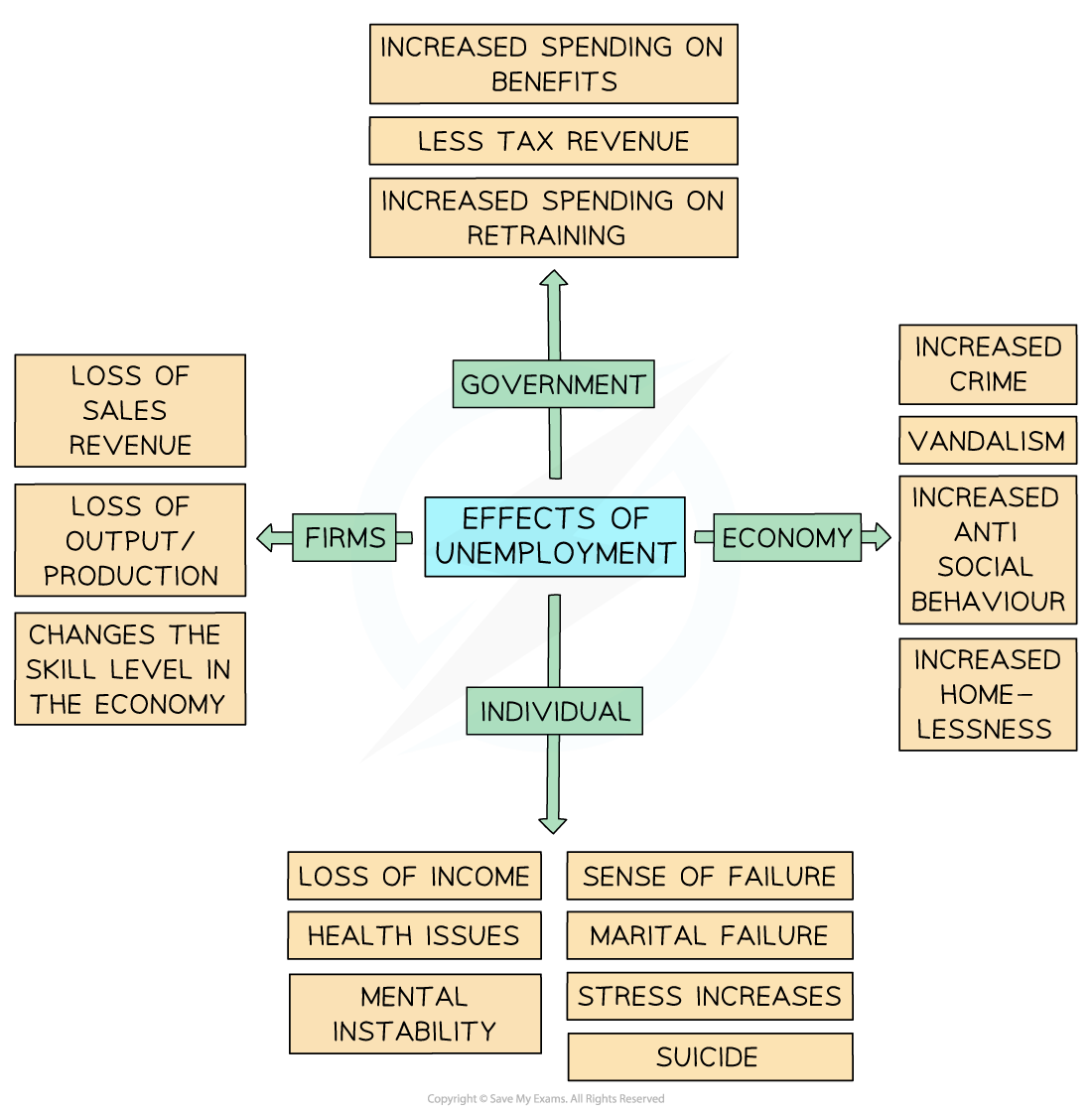An Introduction to Unemployment
- Key terms to understand are employment, labour force, unemployment, and full employment
- Employment: refers to the economic use of labour as a factor of production
- Unemployment: Someone is considered to be unemployed if they are not working but actively seeking work
- Labour force: A country's population is divided into the labour force - and non labour force
- The labour force consists of all workers actively working PLUS the unemployed (who are seeking work)
- The non labour force includes all those not seeking work e.g. stay at home parents, pensioners, and school children (these people are economically inactive)
- Full employment: describes the ideal situation when everyone in the economy who is willing and able to work has a job
Measuring Unemployment
- Unemployment is measured in many countries using two different approaches
- The International Labour Organisation (ILO) Survey
- The Claimant Count
The Differences Between the ILO Labour Force Survey and The Claimant Count
The ILO Labour Force Survey |
The Claimant Count |
|
|
Three Metrics are Commonly used when Analysing the Labour Market in an Economy
Unemployment rate |
Employment rate |
Labor force participation rate |
- The employment rate could be increasing even as the unemployment rate is increasing:
- May be caused by increased immigration which causes working age population to increase
- May be caused as people move from being economically inactive to employed
- Unemployment rates do not capture the hidden unemployment that occurs in the long term
- Workers look for a job but may eventually give up and become economically inactive
- This actually improves the unemployment rate as fewer people are actively seeking work
Worked Example
The table provides information about a country's labour market
| Population size | 4000000 |
| Labour force size | 2400000 |
| Number employed | 1800000 |
| Number of full-time students | 200000 |
Calculate the unemployment rate of this country [2]
Step 1: Decide which information in the table is useful
-
- The number of full time students would not be included in the labour force size, so it is not useful (it is a distraction)
- The key infromation is the labour force size and the number employed
Step 2: Calculate the number of unemployed in the labour force
-
- Labour force - employed = unemployed
- 2,400,000 - 1,800,000 = 600,000 unemployed
Step 3: Calculate the unemployment rate
Difficulties in Measuring Unemployment
- There are several difficulties involved in the measurement and use of unemployment statistics
1. Underemployment
- Workers who are underemployed do not appear in unemployment statistics
- Unlike the unemployed, people who are underemployed are working
- Someone is underemployed when:
- They want to work more hours than they currently work
- They are working in a job that requires lower skills than they have e.g. an architect working as a gym instructor
- Underemployment is often a consequence of cyclical unemployment
- Workers who have lost their jobs in a weak economy are willing to take part-time jobs or accept roles outside of their main skill base
- Workers who have lost their jobs in a weak economy are willing to take part-time jobs or accept roles outside of their main skill base
- Underemployment is also a consequence of structural unemployment
- Unless workers retrain and gain new skills, it will be hard for them to gain full employment
- Unless workers retrain and gain new skills, it will be hard for them to gain full employment
2. Hidden unemployment
- Hidden unemployment occurs when workers lose their jobs and then attempt to get a new job, usually for a very long period of time, after which, they give up
- This often occurs during severe recessions
- They give up looking for work as they feel that they no longer have the skills desired by the market
- Once they stop looking for work, they are no longer considered to be unemployed
- Unemployment rates would be much higher if this hidden unemployment was considered
3. Unemployment disparities
- The headline unemployment rate is an average
- It does not provide insight into ethnic, regional, gender or youth unemployment disparities which may exist in an economy e.g. in 2022 the USA unemployment rate was 3.8% with Nebraska having the lowest unemployment level at 2%.and the District of Columbia the highest at 6%. White workers had an unemployment rate of 3% and black workers 6.5%
Understanding Labour Market Diagrams
- Labour market equilibrium occurs where the demand for labour (DL) is equal to the supply of labour (SL)
- The DL is the demand by firms for workers
- The SL is the supply of labour by workers
- Individual firms are price takers in the labour market as they have to accept the wage rate that workers are being paid in the industry
- If they offer a lower wage, they will likely struggle to recruit workers
- If they offer a higher wage there will be a large number of workers applying to work there

In the labour market for graphic designers, the equilibrium wage rate is W and the equilibrium quantity is Q. At this point the DL = SL
Diagram Analysis
- The market for graphic designers is in equilibrium where DL = SL
- The equilibrium wage is W and the quantity of labour is Q
- There is no excess supply of labour
- There is no excess demand for labour
- There are several causes of unemployment, all of which cause disequilibrium in the labour market. These include:
- Real wage unemployment (minimum wages)
- Structural unemployment
- Cyclical (demand deficient) unemployment
- Frictional unemployment
- Seasonal unemployment
Real Wage Unemployment (Minimum Wages)
- Real wage unemployment occurs when wages are inflexible at a point higher than the free-market equilibrium wage
- Usually caused by the existence of minimum wage laws
- The higher wage creates an excess supply of labour
- This excess supply represents real wage unemployment
-
- A minimum wage is a legally imposed wage level that employers must pay their workers
- It is set above the market rate
- The minimum wage/hour varies based on age
- A minimum wage is a legally imposed wage level that employers must pay their workers

A national minimum wage (NMW1) is imposed above the market wage rate (We) at W1
Diagram Analysis
- The market equilibrium wage and quantity for truck drivers in the UK is seen at WeQe
- The UK government imposes a national minimum wage (NMW) at W1
- Incentivised by higher wages, the supply of labour increases from Qe to Qs
- Facing higher production costs, the demand for labour by firms decreases from Qe to Qd
- This means that at a wage rate of W1 there is an excess supply of labour and the potential for real wage unemployment equal to QdQs
Structural Unemployment
- Occurs when there is a mismatch between jobs and skills in the economy
- It usually happens as the structure of an economy changes e.g. the secondary sector is declining and the tertiary sector is growing
- There is no longer a need for a specific type of worker e.g. shipbuilders in Glasgow
- Many Western industries have relocated production to China causing structural unemployment in their economies
- Unless workers receive help to retrain, they are often left unemployed or under-employed

Structural unemployment occurs in a specific industry when the demand for labour (DL) shifts left as workers are no longer required
Diagram Analysis
- The initial labour market equilibrium in the USA steel industry can be seen at W1Q1
- The USA began to import more and more steel from China and with fewer workers required the demand for labour (DL) shifted left from DL→DL1
- Wages fell from W1→W2 and the quantity of workers in the industry reduced from Q1→Q2 (structurally unemployed)
Cyclical (Demand Deficient) Unemployment
- Cyclical or demand deficient unemployment is caused by a fall in AD in an economy
- This typically happens during a slow down or recession
- The demand for labour is derived from the demand for goods/services
- As output falls in the economy, firms lay off workers

A fall in aggregate demand (AD) leads to a fall in output. Fewer workers are required so the demand for labour (DL) shifts left and wage rates fall
Diagram Analysis
- Using a Keynesian national income model, the macroeconomic equilibrium is initially at AP1YFE
- At this level of national output, the labour market is in equilibrium at W1Q1
- A recession causes AD to shift left from AD1 → AD2
- This leads to a fall in real GDP from YFE → Y1
- With lower levels of output, fewer workers are required and the demand for labour (DL) in the labour market shifts left from DL → DL1
- The new labour market equilibrium is now at W2Q2
- The labour market has a lower wage rate and increased unemployment equal to Q1 - Q2
Frictional and Seasonal Unemployment
- Seasonal unemployment occurs as certain seasons come to an end and labour is not required until the next season
- E.g. fruit pickers; summer seaside resort workers; ski instructors
- E.g. fruit pickers; summer seaside resort workers; ski instructors
- Frictional unemployment occurs when workers are between jobs
- This is usually short-term unemployment
- Workers have voluntarily left their previous job to search for another
The Natural Rate of Unemployment
- The natural rate of unemployment (NRU) is the lowest achievable level of unemployment in an economy
- The unemployment rate can never be 0% as there is always some unemployment due to the existence of frictional, seasonal and structural unemployment
- The natural rate of unemployment = frictional + seasonal + structural unemployment
The Costs of Unemployment
- The effects of unemployment, especially long-term unemployment, are extremely damaging
- There are impacts on the individual, the economy, the government, and firms

Long term unemployment affects individuals, the economy, government, and firms
- Government's receive less tax revenue and have higher expenditures in the form of welfare payments
- Individuals suffer significant emotional, relational and financial consequences
- Firms may find it harder to find workers to employ (as they have moved on) once the economy starts to recover
- The economy contracts as there is a higher level of inefficient use of available resources